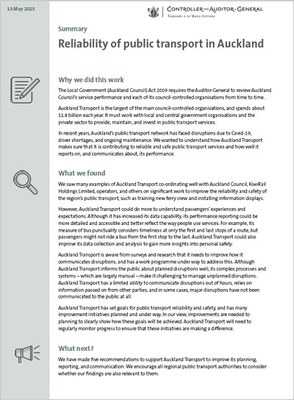Summary of our report
Why we did this work
 The Local Government (Auckland Council) Act 2009 requires the Auditor-General to review Auckland Council’s service performance and each of its council-controlled organisations from time to time.
The Local Government (Auckland Council) Act 2009 requires the Auditor-General to review Auckland Council’s service performance and each of its council-controlled organisations from time to time.
Auckland Transport is the largest of the main council-controlled organisations, and spends about $1.8 billion each year. It must work with local and central government organisations and the private sector to provide, maintain, and invest in public transport services.
In recent years, Auckland’s public transport network has faced disruptions due to Covid-19, driver shortages, and ongoing maintenance. We wanted to understand how Auckland Transport makes sure that it is contributing to reliable and safe public transport services and how well it reports on, and communicates about, its performance.
What we found
We saw many examples of Auckland Transport co-ordinating well with Auckland Council, KiwiRail Holdings Limited, operators, and others on significant work to improve the reliability and safety of the region’s public transport, such as training new ferry crew and installing information displays.
However, Auckland Transport could do more to understand passengers’ experiences and expectations. Although it has increased its data capability, its performance reporting could be more detailed and accessible and better reflect the way people use services. For example, its measure of bus punctuality considers timeliness at only the first and last stops of a route, but passengers might not ride a bus from the first stop to the last. Auckland Transport could also improve its data collection and analysis to gain more insights into personal safety.
Auckland Transport is aware from surveys and research that it needs to improve how it communicates disruptions, and has a work programme under way to address this. Although Auckland Transport informs the public about planned disruptions well, its complex processes and systems – which are largely manual – make it challenging to manage unplanned disruptions. Auckland Transport has a limited ability to communicate disruptions out of hours, relies on information passed on from other parties, and in some cases, major disruptions have not been communicated to the public at all.
Auckland Transport has set goals for public transport reliability and safety, and has many improvement initiatives planned and under way. In our view, improvements are needed to planning to clearly show how these goals will be achieved. Auckland Transport will need to regularly monitor progress to ensure that these initiatives are making a difference.
What next?
We have made five recommendations to support Auckland Transport to improve its planning, reporting, and communication. We encourage all regional public transport authorities to consider whether our findings are also relevant to them.

